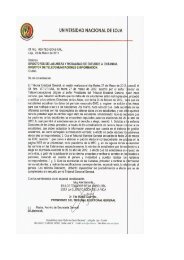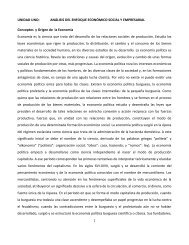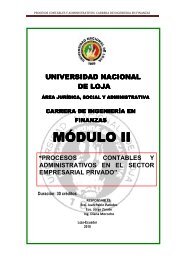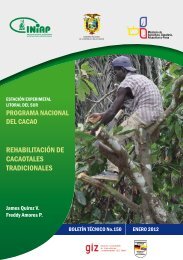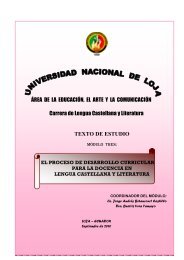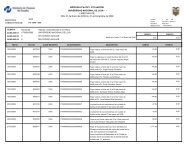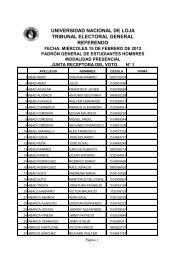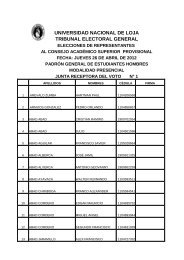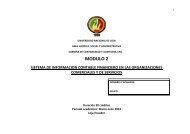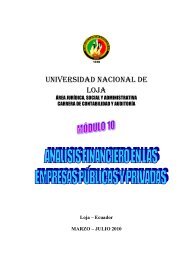module 5 planning of the english language teaching-learning process
module 5 planning of the english language teaching-learning process
module 5 planning of the english language teaching-learning process
You also want an ePaper? Increase the reach of your titles
YUMPU automatically turns print PDFs into web optimized ePapers that Google loves.
UNIVERSIDAD NACIONAL DE LOJA<br />
Área de la Educación el Arte y la Comunicación<br />
English Language Career<br />
and group work are possible, but need more careful <strong>planning</strong>.<br />
• The previous experience <strong>of</strong> <strong>the</strong> students. When students are not used to pair<br />
and group work we need to plan how to introduce this way <strong>of</strong> working. We<br />
can start by doing short pairwork activities and gradually introduce longer<br />
and more varied groupings.<br />
• The activities that we have chosen. For example, a discussion activity can<br />
be done in groups, a role-play can be done in pairs. But we can also<br />
choose to do <strong>the</strong>se activities differently, depending on <strong>the</strong> needs <strong>of</strong> <strong>the</strong><br />
group and <strong>the</strong> aims <strong>of</strong> <strong>the</strong> lesson. So, for example, a discussion activity can<br />
be done in pairs or as a whole class, and a role-play can be done in groups.<br />
• The balance <strong>of</strong> interaction patterns in a lesson. A lesson where learners are<br />
doing pairwork for <strong>the</strong> whole lesson will probably not be successful: learners<br />
will become bored and <strong>the</strong>re might be discipline problems. A lesson where<br />
learners are doing individual work for <strong>the</strong> whole lesson will probably not be<br />
successful ei<strong>the</strong>r: learners will lose concentration and become bored.<br />
Equally, a lesson which is wholly teacher-led is unlikely to be successful:<br />
learners need a balance <strong>of</strong> different interaction patterns within one lesson.<br />
• The group dynamics <strong>of</strong> <strong>the</strong> class, i.e. <strong>the</strong> relationships between <strong>the</strong><br />
students and how students will behave towards each o<strong>the</strong>r.<br />
The first part <strong>of</strong> a lesson plan from a methodology book for primary learners is<br />
below. In each activity learners are grouped in different ways: <strong>the</strong>y work as a<br />
whole class, in groups and individually.<br />
Time Teacher's activity Pupils' activity<br />
5-10<br />
minutes<br />
10 minutes<br />
10 minutes<br />
1. Warmer: brief revision <strong>of</strong> colours, using a<br />
team game.<br />
2. Bring in a goldfish or a picture <strong>of</strong> a fish to<br />
introduce <strong>the</strong> topic to pupils. Discuss <strong>the</strong><br />
fish -what it looks like, its colour, its parts.<br />
Check who has a fish at home.<br />
3. Tell pupils you are going to tell <strong>the</strong>m a<br />
story. In groups pupils predict what <strong>the</strong> story<br />
will be. Get feedback from <strong>the</strong> groups.<br />
4. Explain <strong>the</strong> activity, i.e. pupils have to<br />
colour <strong>the</strong>ir fish as <strong>the</strong> story requests. Give<br />
out colours and photocopies <strong>of</strong> a fish<br />
drawing.<br />
5. Tell <strong>the</strong> first part <strong>of</strong> <strong>the</strong> story with actions<br />
and pictures, continue <strong>the</strong> story with<br />
instructions for colouring.<br />
Pupils stand in lines behind flags<br />
.<strong>of</strong> different colours. The teacher<br />
says a colour. Pupils behind <strong>the</strong><br />
flag <strong>of</strong> that colour put up <strong>the</strong>ir<br />
hands.<br />
Pupils ga<strong>the</strong>r round <strong>the</strong> tank and<br />
say what <strong>the</strong>y know about fish.<br />
They tell each o<strong>the</strong>r something<br />
about <strong>the</strong>ir own fish. Pupils talk<br />
toge<strong>the</strong>r to try and guess what will<br />
be in <strong>the</strong> story.<br />
Group monitors give out crayons<br />
and blank sheets.<br />
Pupils colour in <strong>the</strong> fish drawings<br />
following instructions.<br />
The interaction patterns in <strong>the</strong> lesson are:<br />
[Escribir texto] Página 105



